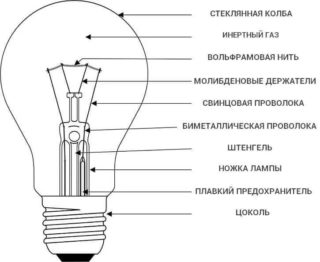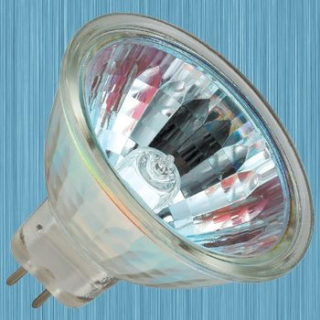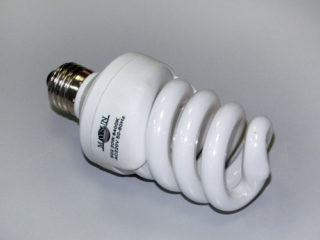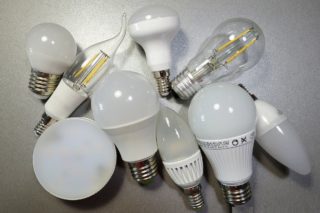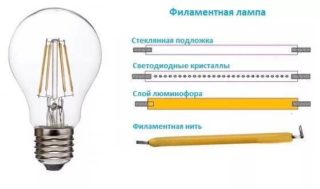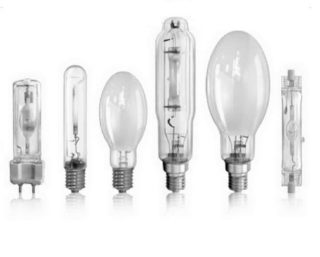Arranging a lighting system is one of the most important tasks in any home. You can make lights using different types of lights. They all differ in their characteristics, properties and value. Bulbs can be used in lamps of various types, to highlight the floor and furniture. When planning the lighting in an apartment, you need to deal with the individual characteristics of each type of light bulb in advance and choose the best option.
Lighting Specifications
The active development of modern technology has led to the creation of a wide variety of light bulbs, as well as to the complication of choosing the best device for the home. Previously, classic incandescent bulbs were used almost everywhere, but now there are more varieties used.
All types of light bulbs for the home have the same set of characteristics. These parameters are related to what kind of lighting will be created in the room and how comfortable and safe it will be for the human eye.
The main characteristics of lighting devices are:
- Lamp power. Shows how much power the device consumes. It is important not to confuse - the brightness of the glow does not depend on power. It is determined by other parameters.
- View of the basement. Depends on the lamp in which the lamp will be installed. Most household appliances use cartridges E14 and E27. These are two similar screw bases with different diameters. In ceiling chandeliers with small shades and specific fixtures, pin lamps can be installed, which are usually called the letter G. In the spotlights, the R7S connector is used.
- The shape and size of the flask. Models with threaded base come in the form of a pear, ball, candle. Products with a pin are in the form of a small capsule, a flat reflector. They vary in length. What a long bulb is called depends on the design.
- Illumination. This indicator is individual for each type of premises. Depends on such factors as the distance to the light source, the color of the walls, the reflection of rays from objects in the room.
- Color rendering. This is an indicator of how close the artificial light emitted from the lamp is to the sunlight. The color rendering index can be called Ra or CRI, and it is measured from 1 to 100. The lamp has good color rendering if its index is more than 60Ra. Very good color rendition - from 80 Ra.
- Light flow. This is the power of radiant energy, estimated by the light sensation. Directly depends on the power of the bulb.
- Colour temperature. According to this indicator, bulbs can be divided into products that give warm yellow (2700-3500 K), cold (6400 K and above) and daylight white (3500-4500 K) colors.
The quality of the materials from which they are assembled also affects the characteristics of the lamps. Therefore, it is important to buy products from trusted manufacturers.
Types of fixtures
The range of lighting products is wide. On the shelves of stores you can see incandescent lamps, halogen, fluorescent, LED and other devices. Different types of lighting lamps have their own technical characteristics and design.
Incandescent lamps
This device, which consists of a cap, contacts, fuse, tungsten filament and a glass bulb. Inside the bulb is also a mixture of inert gases or in some lamps a vacuum.
An electric current is supplied through the conductor. The spiral is heated, which emits light particles.
Incandescent lamps vary in size, type of bulb design, there are also krypton and bispiral devices.
Characteristics:
- light output up to 19 Lm / W;
- power from 25 W to 150 W;
- service life - 1000 hours;
- Efficiency up to 30%.
The advantages of incandescent lamps include low cost, ease of installation and a pleasant yellow light. Cons - fragility, burnout during power surges, the complexity of disposal, surface heating, short service life.
Halogen bulbs
By design, halogens are similar to incandescent bulbs. But instead of inert gas, the flask is filled with halogens (bromine, iodine). Due to this, the evaporation of the heating part decreases and its temperature increases.
Halogen products are not only with a base, but also linear in the form of a tube. Devices with high impact resistance and bright intense light are used in streetlights. Miniature low-voltage capsule lamps are often placed in chandeliers and suspended ceilings. To connect them, a step-down transformer is required.
Specifications:
- power up to 20 W;
- color rendering index 100%;
- flask heating temperature up to 500 ° С;
- light output 15-22 Lm / W;
- operating temperature range -60 ° to + 100 ° C;
- operating time 2000-4000 hours, using a transformer, the service life is increased to 8000 hours;
- Efficiency 50-80%.
Benefits:
- service life is higher than that of incandescent lamps;
- miniature of some models;
- excellent color rendering;
- There are products with both a warm and a cold tint.
The disadvantages of halogen lamps are strong heating, poor resistance to power surges, and you can’t touch the bulb with your hands.
Fluorescent lamps
Devices consist of a flask on the inner surface of which a phosphor is applied. The flask is filled with a mixture of mercury vapor and inert gases. To work, you need electronic or mechanical ballast.
Lamps give colors of different shades. They are marked with the letters - LTB (warm white), LHB (cold), LE (natural).
Devices come in various shapes - linear and compact. The former are made in the form of tubes, the latter in the form of spirals.
Specifications:
- light output 40-80 Lm / W;
- operating time up to 40,000 hours;
- power 15-80W.
Benefits:
- low power consumption;
- low bulb temperature during operation;
- high light output;
- duration of work.
The disadvantages of luminescent products include environmental friendliness, complexity of disposal, high cost, instability at zero and lower temperatures, long start-up time. Also, the lamps have a limited cycle of on and off.
LED lamp
The basis of LED sources is a semiconductor crystal. When current is applied, light particles are released.
The design of the device contains an LED matrix, a base, a driver, a radiator, a flask, an aluminum substrate.
Specifications:
- power up to 30 W;
- working time 30-50 thousand hours;
- light output of 100-120 lm / W;
- luminous flux 250-2500 Lm;
- color rendering index from 75 Ra.
Benefits:
- environmental friendliness;
- low power consumption;
- high efficiency;
- lack of thermal, IR and UV radiation;
- do not require special disposal conditions;
- safety;
- light up instantly;
- don't flicker.
Minus of LED lamps - high cost. The price depends on many factors - manufacturer, additional options.
Filament lamps
A variety of LED sources is a filament light lamp. It works from a special element - filament, which is a strip with special design LEDs.
They have the same characteristics as LED bulbs. In comparison with luminescent sources light up instantly, and also they can be dimmed.
Discharge lamps
High-pressure discharge lamps were created as an alternative to fluorescent sources, but with more power. In such devices, immediately after switching on, a glow discharge occurs.In the lamp, pressure increases and an arc appears, which gives powerful light radiation.
In such models, visible light is blue. For adjustment, quartz glass burners are used. The result is an arc mercury fluorescent light bulb (DRL). Used such devices for street lighting. The disadvantage is the high cost due to the use of a bulb with a phosphor. Also, such devices have poor color reproduction and become cloudy over time.
Due to these shortcomings, DRLs were supplanted by sodium sources. They are arranged in a similar way, but instead of mercury, the flask is filled with sodium vapor. The lamps look brighter due to the wide coverage of the yellow colors of the spectrum. They are used for lighting on the street and in agriculture (greenhouses, poultry farming, livestock complexes). An important disadvantage is incorrect color rendering.
Correct color reproduction is possessed by ultrahigh-pressure mercury bulbs and a xenon light source. DRS (arc mercury spherical sources) are a quartz burner in the form of a ball. They have the greatest strength. Less - a large amount of ultraviolet radiation, explosiveness.
Xenon lamps do not contain metals inside, they became widespread after the development of the semiconductor industry. Give the closest to natural light. Used in car headlights, camera flashes, film projectors.


